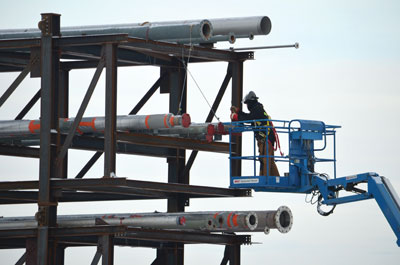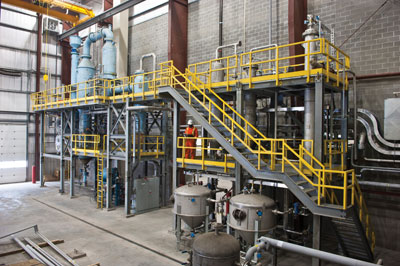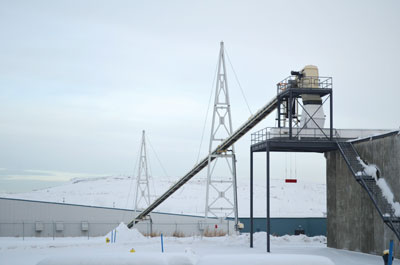
Edmonton Turns Waste into Fuel
February 15, 2013
By
Andrew Macklin
The production of biofuel from waste has taken a step forward in Canada, as the country’s first full-scale commercial plant for the production of cellulosic ethanol hits the construction phase.
The production of biofuel from waste has taken a step forward in Canada, as the country’s first full-scale commercial plant for the production of cellulosic ethanol hits the construction phase. The proprietary thermochemical technology platform created by Enerkem is providing the City of Edmonton with another component for its world-class waste management facility.
 |
|
| Construction of the gasifier is underway at Enerkem’s commercial plant in Edmonton.
|
The City of Edmonton has already established itself as a world leader in waste management. Before the Enerkem project began, the city was already diverting close to 60% of its municipal waste away from its landfill. Among its innovations, Edmonton has a paper recycling plant on the site of the waste management facility, and the recycled paper products created are used as the paper stock for the municipality.
The $131-million project includes the feedstock prep facility, a commercial plant, and the Advanced Energy Research facility. The $100-million waste-to-biofuels commercial plant will be owned and operated by Enerkem; the remaining $31 million covers the cost of the Integrated Transfer and Processing Facility and the Advanced Energy Research Facility. These two facilities are owned and operated by the City of Edmonton.
The commercial biofuels plant will run all day, every day, in order to process the volume of residential and commercial waste that will be taken in. The resulting production volume is estimated at 4,500 litres of fuel grade cellulosic ethanol per hour, and approximately 38 million litres of cellulosic ethanol over the course of a year. That volume represents approximately 14% of the ethanol needed by the province of Alberta to meet Canada’s 5% ethanol blend requirements for fuel.
Enerkem’s Technology
Since 2000, Enerkem has been working on research and development projects that would allow the company to produce a commercial-size waste-to-biofuels plant. Headquartered in Montreal, the company, founded by the father and son team of Esteban and Vincent Chornet, has been working on validating its proprietary technology for the last decade.
 |
|
| Inside the Advanced Energy Research Facility in Edmonton, work is being done to test syngas for secondary end products. Photo: Enerkem |
The end result has been the creation of a financially sustainable solution for breaking down a variety of feedstocks and solid waste for the production of methanol and cellulosic ethanol. Enerkem currently has two facilities operational in Quebec, with a pilot plant in Sherbrooke and a commercial demonstration plant in Westbury. Two facilities similar to the Edmonton project are also in development, with one in Varennes, Quebec (in partnership with GreenField Ethanol) and the other in Pontotoc, Mississippi.
Enerkem’s four-step thermochemical process involves the preparation of feedstock, gasification of the feedstock, the cleaning and conditioning of syngas, and then catalytic synthesis.
“We produce chemical-grade syngas that is suitable for many applications,” explains David Lynch, general manager of research and development for Enerkem. “We then use commercially available catalysts to produce end products like methanol and cellulosic ethanol.”
Methanol can be used as the end product, providing a saleable product for the commercial market without going through the secondary refinement stage. However, Enerkem is committed to the production of cellulosic ethanol at the facilities it has built.
The plant being constructed at the waste management facility in Edmonton is based on a standard plant design from Enerkem that consists of prefabricated modules. The six-acre plant site is strategically located between the demonstration plant and the feedstock preparation facility, and will have the foundation in place to double in size should future demand require the plant’s expansion.
Refining the Technology
The commercial-scale plant being built in Edmonton follows extensive testing and analysis done at the company’s demonstration and pilot plants in Quebec. The demonstration facility, located in Westbury, allowed Enerkem to confirm the process design of its proprietary technology for its deployment at its full-scale commercial plant in Edmonton. Today, the facility produces fuel-grade cellulosic ethanol from waste.
 |
|
| A conveyor system runs from the feedstock preparation facility to the gasifier chamber. Photo: Enerkem |
In addition to its commercial facility under construction, Enerkem has delivered a smaller-scale system for the Advanced Energy Research Facility operated by the City of Edmonton on the same site. Built at a 5% scale of the commercial plant, the Advanced Energy Research Facility has the ability to process a broad range of waste and biomass feedstocks and to utilize the syngas produced to evaluate numerous down-stream technologies.
This plant is linked to a research lab found in the same facility, which has been performing a series of tests focused on the reduction of greenhouse gas emissions from waste and biomass sources. Analytical services for the commercial plant will also be managed through the lab.
The demonstration plant and lab also provides an opportunity to research other end products that could be produced.
Gasification optimization was the initial role of the research facility, but with the methanol and ethanol creation processes refined, that focus has been broadened to look at applying the Enerkem technology to new and existing Alberta industries.
“The primary focus of the research facility, moving forward, will be to broaden the types of feedstocks that can be used,” says Lynch. “We want to research opportunities for using shredded materials from motor vehicles, different types of wood materials, as well as refinery waste.”
In addition to the use of new feedstocks, the team is also conducting extensive research looking into other beneficial uses for syngas.
“What else do you want to make from your syngas?” asks Lynch. “We are looking at how we might create dimethyl carbonate by injecting CO2 directly into the molecule, as well as the ability to create dimethyl-ether as a possible secondary end product. We also want to better understand when and how CO2 can offset the use of steam in the process. These are just a few of the possibilities that we will be researching in the lab.”
It won’t just be researchers from Enerkem either. The lab is available to other researchers that are doing similar work to what is being done by Enerkem’s own staff. That opportunity will help not only to further Enerkem’s work, but also to build new research networks and partnerships both nationally and globally.
Waste-to-Biofuel
The commercial plant will begin producing methanol in 2013 and will then focus solely on the production of cellulosic ethanol, with the estimated 4,500 litres per hour target to be achieved as soon as the plant is fully operational in 2014. All processes of the plant will run 24 hours a day, in order to both process the supply of waste and to meet production targets.
The process begins at the feedstock preparation facility, where the garbage is separated. Trash that can be recycled through other methods, such as compost, plastic containers and paper products, is removed from the waste. A high-powered magnet is also run through the materials to remove any metals from the process. The remaining waste is then processed through a shredder before it is placed on the conveyor system. The conveyor system runs several hundred feet from the preparation facility to the gasifier, with the conveyor’s incline supported by a pair of metal structures.
The chamber, which stores the waste before it enters the gasifier, provides continuous flow of the shredded waste to the gasifier where it is processed under low severity conditions. The 1-2 bar pressure used in the Enerkem gasifier is lower than what is found in a standard motor vehicle tire. The gasifier in the plant has a bubbling fluid bed which has an average temperature of less than 700°C. The bottom of the bed is filled with hot sand. Steam and a small amount of oxygen are blown through the hot sand, which then rapidly decomposes the feedstock. The resulting syngas is then cleaned and conditioned before being used for catalytic synthesis, resulting in cellulosic ethanol.
If the ethanol production in Edmonton meets the expected target of 38 million litres produced annually, the fuel produced at the facility will equal 14% of the province’s Renewable Fuel Standard (RFS) or 400,000 cars’ worth of ethanol additive. As of now, the ethanol used in Alberta’s gasoline is being imported from outside of the province. With 38 million litres produced in Alberta, that’s less fuel being used, and less money being spent, to import ethanol.
Overall, the project will help the City of Edmonton to continue to be recognized as a world leader in waste management. The diversion of waste for the creation of biofuel will allow the city to increase its landfill-diverted household waste from around 60% to approximately 90%, while also creating a needed resource for the province that was previously imported. With completion targeted for later this year for methanol production, this world-class facility will serve as a model for other communities across Canada that are looking for new ways to control waste and reduce their carbon footprint.
Print this page